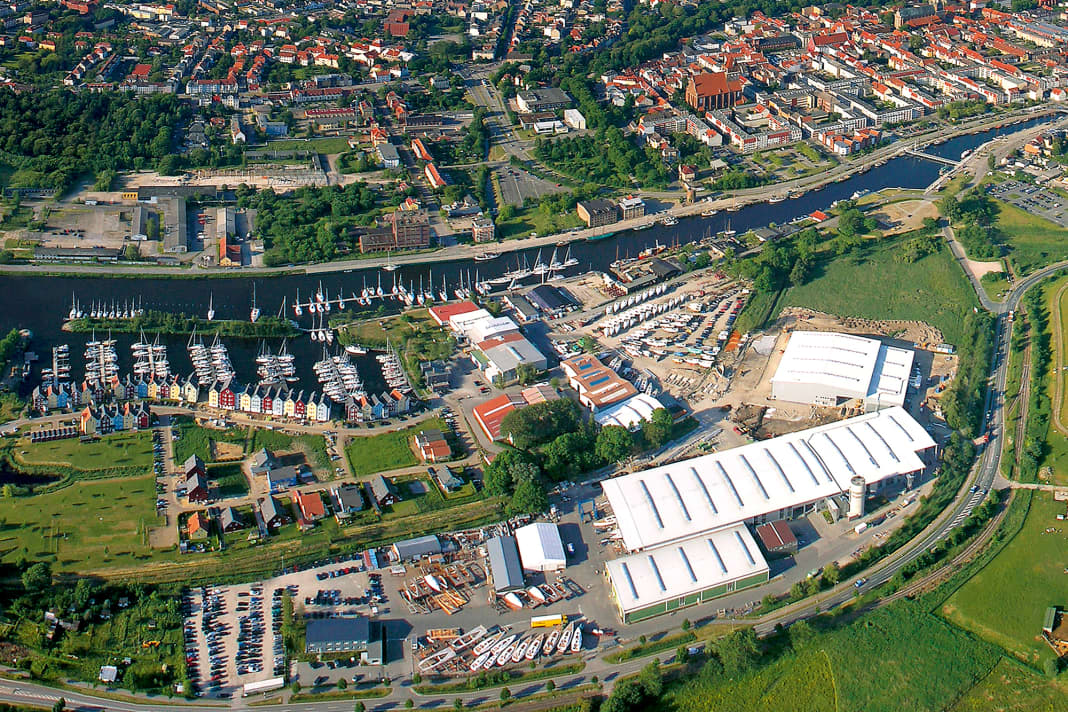





1. hanseyachts AG- from Greifswald to the whole world
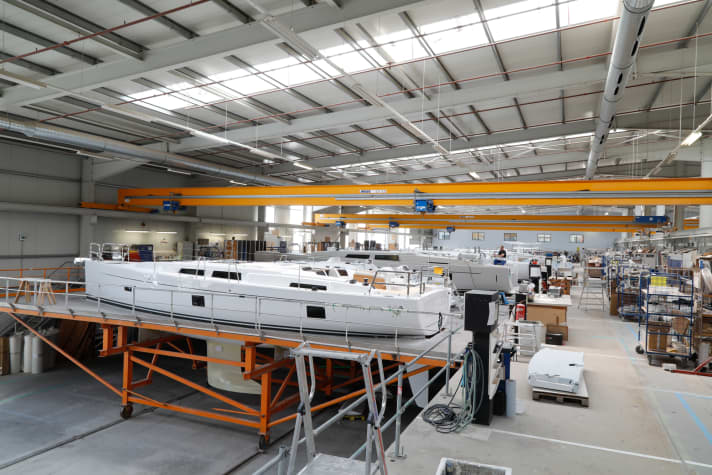
If you don't know it, it's hard to believe: the third largest shipyard after the Beneteau Group and the Dufour/Fountaine Pajot group (all French) is located in Germany, more precisely in the beautiful university and Hanseatic town of Greifswald on the Bodden of the same name between Stralsund and the Polish border. Measured by the number of yachts built, the company even believes it is in second place worldwide.
There, on the banks of the River Ryck and thus unlike most large shipyards with direct access to the water, the Hanseyachts AG series production facility builds sailing yachts of the following types Hanseatic League , Dehler , Moody and motorboats named Sealine, Ryck and Fjord. While GRP production takes place in plants near Szczecin and in the industrial area of Greifswald, furniture production, finishing, installations and final assembly are carried out at the headquarters in Salinenstraße. With around 1,500 employees, the shipyard is one of the top 20 largest employers in the state of Mecklenburg-Vorpommern.
In Greifswald, the furniture production, which is highly automated, is particularly impressive, as are the further construction steps on the assembly lines, where the complex world of a sailing boat grows together from many hundreds of parts.
Robots, painting lines, assembly lines: Who would have thought it when regatta sailor, boat broker and owner of the small Wedel boatyard Michael Schmidt travelled through the opening up of the East in 1989 after the fall of the Berlin Wall and came across the remains of the Greifswald boat and repair yard in Greifswald, whose assets were available cheaply. The charismatic non-comformist Schmidt invested and took a risk, building his first series boat there using the old moulds of the Swedish Aphrodite 29. The Hanse 291 is exhibited at the Hamburg Boat Show as the so-called Hansehammer, for 44,444 Deutschmarks. The first own developments with the Judel/Vrolijk design office - they knew each other from joint Admiral's Cup projects - followed in 1993. The boats became larger, the loft style characterised them, as did a high degree of customisability and low prices.
This was followed by unprecedented and sometimes painful growth, acquisitions of the traditional English brand Moody and the takeover of the German series manufacturer Dehler. Then, in 2011, the investor Aurelius AG acquired a majority stake in the shipyard, Schmidt left and built another shipyard, YYachts, also in Greifswald. Today, the group builds eleven models from 31 to 76 feet for Hanse alone, plus six models from Dehler and four from Moody.
2nd HCC Bådeværft, Marstal- Maritime heritage with a view to the future
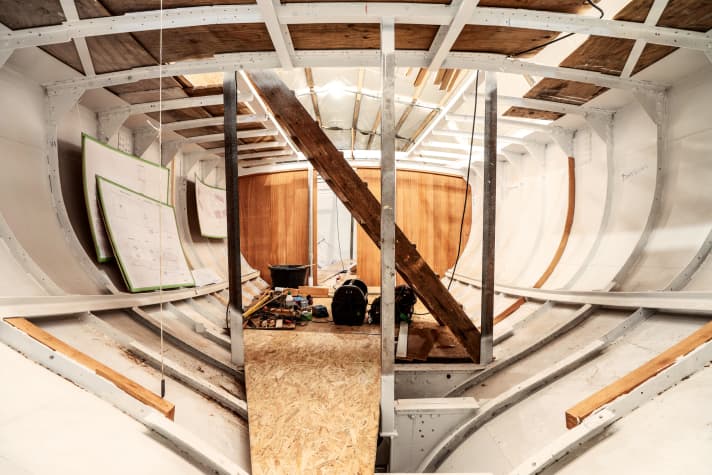
Formerly run by Denmark's veteran boatbuilder Ebbe Andersen, the shipyard's location in the peculiar large yellow hall is the first thing that catches the eye of visitors arriving on their own keel in Marstal on the small South Fyn island of Ærø.
The company has been operating under the name HCC Bådeværft for several years and brings together almost all the maritime trades of traditional sailing under one roof. The team there specialises in wooden boat work, from new builds to repairs, and includes a sailmaker's workshop as well as a production facility for blocks and other rig components. There is also winter storage, engine and electrical work.
Under Ebbe's aegis, the schooner "Bonavista" was renovated from the ground up in Marstal for over twelve years with interruptions - a monument to the great age of Danish sailing, when Marstal managed the largest fleet in the kingdom after Copenhagen, which travelled all over the world. A time and a setting that was immortalised in the masterful seafaring novel "We Drowned" by the writer Carsten Jensen.
Monica Fabricius, who was born in Marstal, worked as an apprentice on the "Bonavista". The passionate sailor then took over her training company from Ebbe in 2015. The block production, which had been based near Svendborg for many years, was added.
Fabricius' HCC Bådeværft recently attracted attention with the extensive restoration and conversion of the 63-foot above-deck ketch "Talisman", which was built in 1920 and manages the balancing act between tradition and modernity. This first steel yacht from the renowned Bremen shipyard Abeking & Rasmussen underwent an extensive total refit in Marstal and was fitted with a 125 kilowatt electric drive with lithium battery bank, generator backup, solar sails, electric underfloor heating and a waste water treatment system. "Talisman" can at least be admired from the outside in Marstal, and the shipyard can also be admired from the inside. And the historic town is always worth a visit anyway.
3rd X-Yachts, Haderslev- Danish Dynamite from the barn
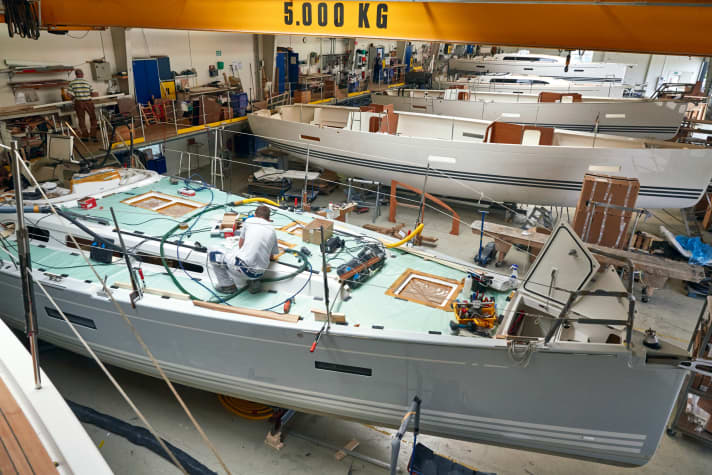
X-Yachts started out like the tech giants Apple and Microsoft in the 1970s, but even more rustic: instead of a garage, the company was founded in a barn. Sailors Lars and Niels Jeppesen and Birger Hansen built their first boat there, the unconventional X-79, named after the year it was founded. With the flat glider, they beat the competition of over 1,500 boats in the then popular Seeland Rund regatta to such an extent that their first boat was bought by a competitor immediately after crossing the finish line. A whopping 468 units followed.
Major victories in the IOR regatta scene, individual constructions ("Handelsbanken"), strong standardised classes such as the X-99 and, for the most part, highly acclaimed performance cruisers characterised the varied model history of the rapidly growing shipyard.
Today, the largest Danish manufacturer is solidly based on three model series: XPerformance refers to sporty boats suitable for regattas, XCruising stands for fast, robust cruising yachts with a timeless look, and the latest line, called Pure X, focuses on the old strengths: performance cruisers positioned between the other two series. They now also have a motorboat in their programme.
Niels Jeppesen, the long-standing in-house designer, and the two other founders have since left the company, but the X gene remains. Despite strong competition, particularly from Italian shipyards such as Cantiere del Pardo ("Grand Soleil") and Solaris, X-Yachts is a top address in its class of sporty yachts built to a high standard of craftsmanship.
The shipyard is located at the end of the picturesque Haderslev Fjord, which is almost ten nautical miles long and leads from the Little Belt near Årøsund into the centre of Jutland, making it a beautiful destination away from the crowds.
4th Henningsen & Steckmest, Kappeln- where boats mature like a Scottish single malt

The stark contrast to large-scale production in the style of Hanseyachts can be found in Kappeln on the Schlei, where there is the highest density of shipyards in Germany. There, in the manufactory of the family business Henningsen & Steckmest, they produce exactly one boat a year, most recently three from the Type Scalar 40.
While the hulls are conventionally made from GRP, the decks are manufactured using traditional timber construction methods: The boat builders mount a plywood deck on beams, which is covered with teak rods; the superstructure is laminated in mahogany and painted natural. A unique selling point in this size of boat, which characterises the appearance and charm of the boats, which are almost like one-offs, which Henningsen & Steckmest sometimes also produce.
A visit to the shipyard is therefore worthwhile to experience semi-traditional boatbuilding. The factory gates are usually open. The shipyard's own harbour, which exudes a special atmosphere with its many individual boats and is within walking distance of other businesses such as the Stapelfeldt and Janssen & Renckhoff yacht and boatyards, is ideal for mooring.
5. museum shipyard Greifswald e. V.- the self-help shipyard with cutter & culture
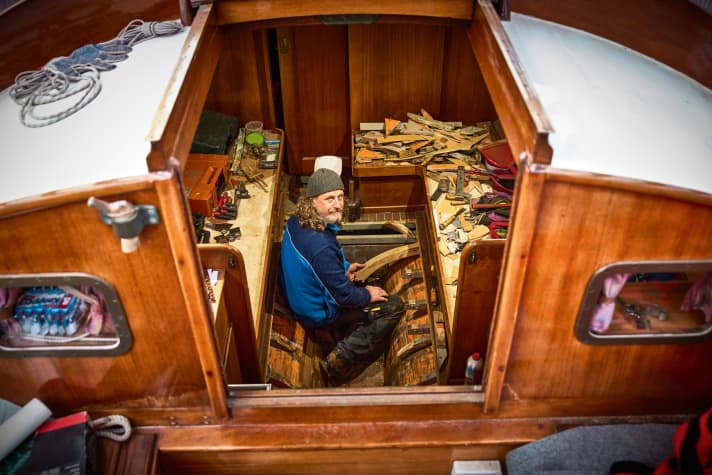
The northern bank of the River Ryck in Greifswald between Stralsund and the Polish border has a long maritime history: from the medieval merchant ships of the Hanseatic era to the cutter construction of the GDR era and the modern production boats made of GRP from Hanseyachts.
Until 1990, mainly cutters were built and repaired on the site and within the old walls of the current museum shipyard. The ideal location for a company whose association has not only set itself the task of preserving the town's maritime heritage, but also offers a wide range of self-help services for lovers of traditional wood-planked ships.
Owners can use the historic slipway, old and new stand machines such as a jointer, band saw, cross-cut saw, thickness planer, milling machine and also the traditional steam box for steaming and bending wooden parts, with the help or just brief instruction of the experts on site. The two boatbuilding halls have space for boats up to twelve metres in length. There is also a wood workshop and a multi-purpose hall.
Large and small projects relating to wooden boat building and refurbishment are welcome, and a usage fee is agreed with the shipyard, which in turn benefits the shipyard and its facilities. Winter storage is also possible, and cultural events are sometimes organised there in the summer. The shipyard also organises publicly funded projects to support young people in their career choices.
The museum shipyard on the one hand and its big neighbour Hanseyachts on the other represent a huge spectrum of shipbuilding, and there is plenty for interested visitors to see at both locations. There is also YYachts/Michael Schmidt Yachtbau in the Ladebow district. The manufacturer of carbon yachts from 70 feet upwards is not easy to visit, but occasionally one of the superyachts worth seeing in Greifswald-Wieck can be marvelled at in the water or out on the Bodden. All in all, this makes the beautiful university town of Greifswald a worthwhile stop or even a start-and-finish harbour, as you can also charter there.
6th Faurby and Nordship, Lunderskov- Customised products from the double manufactory
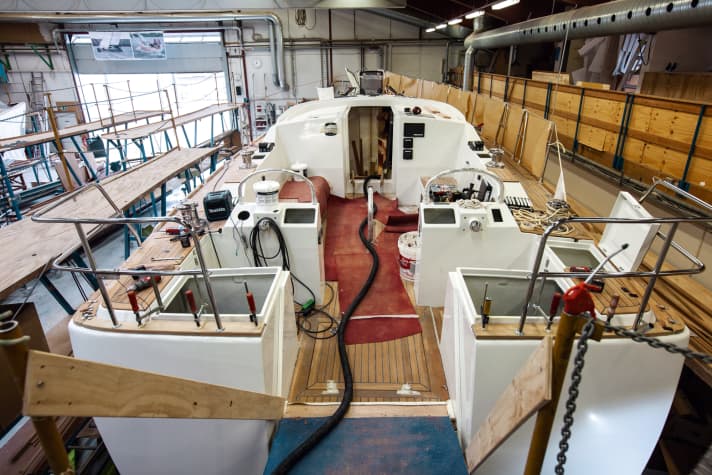
Both GRP and wood processing have a long tradition in the small Danish town of Lunderskov. As Lunderskov Möbler, or "LM" for short, the town name was even part of a shipyard designation for a time. Although this chapter is now closed, the local boatbuilding expertise was one of the reasons for the establishment of two other well-known shipyards.
Today in Lunderskov yachts from Nordship and Faurby built. The two brands share the production facility. What may seem unusual in view of the very different design, fits together very well on closer inspection. Both Nordship and Faurby attach great importance to individualisation. Realising the owner's wishes is an integral part of the concept, which is why both companies work with a high degree of craftsmanship. This is also noticeable during the visit. CNC milling machines and painting lines are nowhere to be found; instead, you can smell the freshly sawn wood. Where elsewhere machine operators monitor the machines, a host of boat builders and carpenters are at work building customised laminated edgings or adapting cupboards so that the owner's desired cooking utensils can be optimally stowed away. Depending on the order situation, the halls are sometimes filled with deck saloon yachts and sometimes with slim faurbys. As practically every boat is an individual construction, this constant change is not a problem.
Anyone interested in a Faurby or Nordship is expressly invited to visit the shipyard. If you don't want to be quite so obligatory, an open day is a good option. As a rule, both shipyards organise an in-house exhibition in March. At this early time of year, it is not a great disadvantage that Lunderskov is about 15 kilometres inland and therefore cannot be reached on your own keel.
7th Quorning Boats, Skærbæk- Large dragonflies from the Little Belt
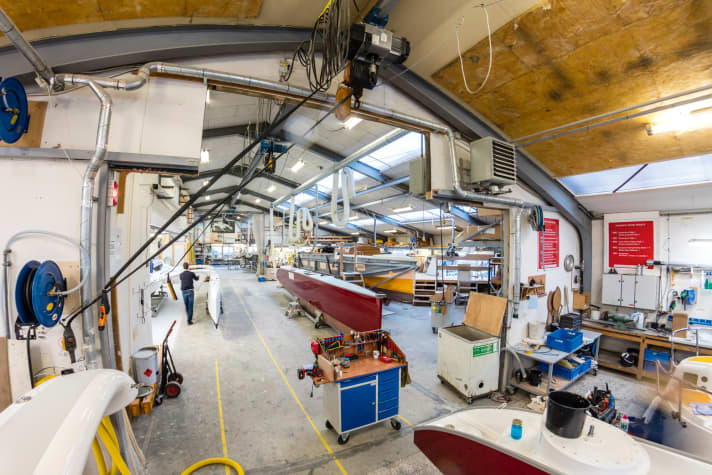
Trimarans for cruising come - logically - from France, where the large and varied regatta scene also has a significant influence on the development of cruising boats? Far from it. The best trimarans come from the tranquil town of Skærbæk on the Kolding Fjord in Jutland. This is where the Dragonflys are built in the owner-managed Quorning family business.
Børge Quorning founded it in 1967 after he had learnt about the Tris, which were still not very common in Northern Europe, in Canada. The shipyard offered its first trihull called Trident at trade fairs and there was great interest, but nobody wanted to buy. During the day, the Quornings built motorboats on the Kolding Fjord, and in the evenings they devoted themselves to their passion, the Tris. Sales grew slowly, but steadily at first. A booster for the fast racers was the 1985 Round Britain Race, which Børge's sons Jens and Eric completed with two boats in first and second place.
Jens Quorning has been managing the shipyard for a long time, and with great success. Alongside the Vietnamese manufacturer Corsair Marine, Quorning Boats is one of the leading shipyards for cruising performance trimarans. The company became big thanks to the swing-wing system developed by Børge and Jens Quorning in 1989, which is complex to manufacture and install and therefore expensive, but reduces the width of the boats to harbour and trailer-friendly dimensions, thus eliminating one of their major disadvantages.
Today, the shipyard builds types 25, 28, 32 and even a 40. The boats regularly win internationally renowned prizes, most recently the flagship, which was named European Yacht of the Year and was also able to prevail against monohulls.
The shipyard itself offers a Dragonfly 28 as a weekly charter boat from Skærbæk for sailors who want to take a closer look at trimarans. Visits to the shipyard are currently only possible to a very limited extent due to the high capacity utilisation.
8th shipyard Rammin- Zeesboote and more on the Barther Bodden
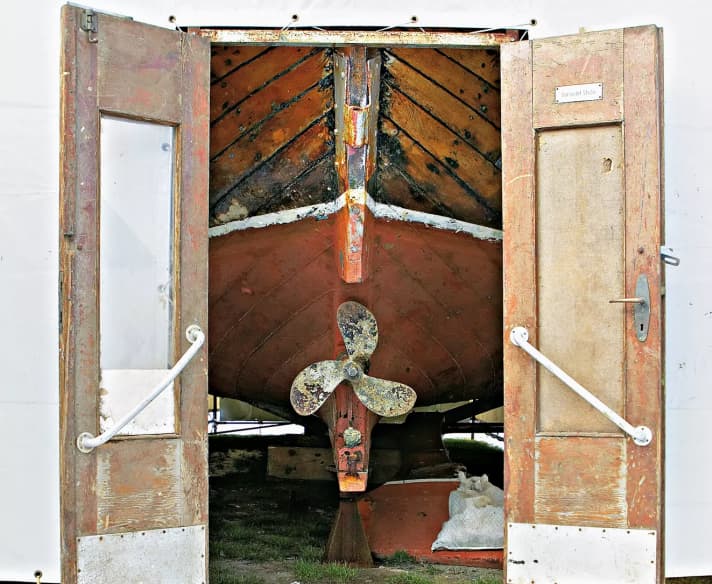
The East German shipyard landscape offers far more than just the large series manufacturer Hanseyachts or the small manufactory Bootsbau Rügen in Lauterbach, manufacturer of the small and individual Vilm series.
The Rammin shipyard is idyllically located in Barth on the Bodden of the same name between the island of Zingst and the Mecklenburg-Vorpommern mainland. The company, run by master boat builder Nils Rammin, repairs and maintains commercial vessels and yachts, offers winter storage and also specialises in the construction of new wooden ships. They are particularly dedicated to Zeesboote, the flat-bottomed centreboard boats that were once used for fishing in the Bodden and coastal waters and which still characterise the region's maritime heritage today.
For example, the shipyard has completely overhauled the large Zeese "Fortuna", the last flounder boat still built without an engine and, with a length of over twelve metres, an exceptionally large example of its kind (see also YACHT 11/2018 ). There are still around 110 Zeesboote, so there is plenty for the Rammin shipyard to do. It presents itself as extremely versatile. It continues to specialise in wooden and steel fishing boats, refits engines, electronics and technology, converts existing yachts and builds hulls from various materials.
There is space for 400 yachts in winter storage, which can enter the harbour with a draught of up to three metres, the crane can lift 64 tonnes, and the shipyard even offers enough space and facilities for catamarans.
In view of the shipyard's diverse activities, there is always something to see and visitors are always welcome. A detour through the very well-protected Barther Bodden, which is well worth seeing, should therefore be worthwhile. Barth can be reached from the Barhöfter Rinne after around twelve nautical miles, is itself a beautiful cruising destination with very good supply options and is also close to the waters of Rügen and the city's highlight, the Hanseatic city of Stralsund.
9. museum shipyard Flensburg- the highs in the north
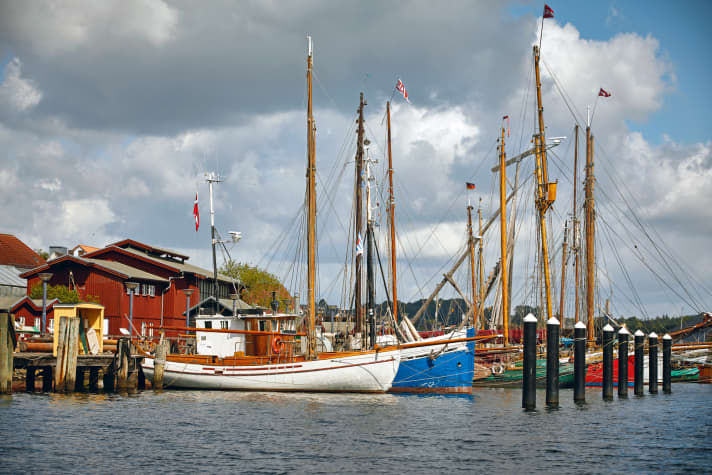
The privately financed Flensburg museum shipyard is dedicated to preserving classic yachts and workboats from the 18th and 19th centuries. On top of this, the company aims to support boat owners with valuations and purchase advice and also offers various workshops and events. Kayak hire and a boatyard café are attached to the museum.
Another highlight in Flensburg is the Robbe & Berking Classics shipyard, which has a restaurant and the most important collection of yachting literature in the world. The issue takes place after registration at the e-mail addressclassics@robbeberking.de.
10th Rosättra Båtvarv, Norrtälje- Innovation meets tradition
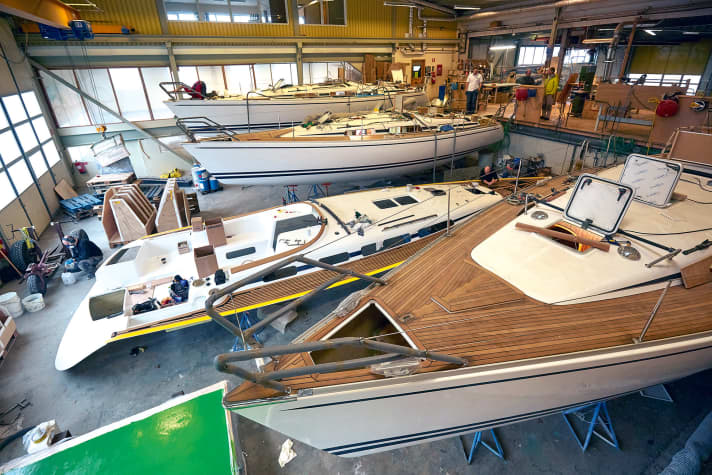
The location of Rosättra Båtvarv on Vätösund in the very north of the Stockholm archipelago is both picturesque and remote. The family business is the oldest shipyard still in production in Sweden. Boats have been built there for more than 150 years - first dinghies and steam sloops, later archipelago cruisers and wooden Laurin Koster. Since the seventies, the boats have been called Linjett. The yachts with the "L" in the sail are practically designed into the area. A sloping stem for mooring on the rocks is therefore part of their DNA, as are a moderate draught and sophisticated detail solutions. The radical full-carbon cruiser-racers of the Shogun series, also built by Rosättra, form an enormous contrast to the conservative Linjetts, but are no less impressive. A special feature is the shipyard's own harbour, where around 50 Linjet owners are moored; there are no guest berths. However, the harbour can be called at by prior arrangement, and the neighbouring service company is available for repairs.

